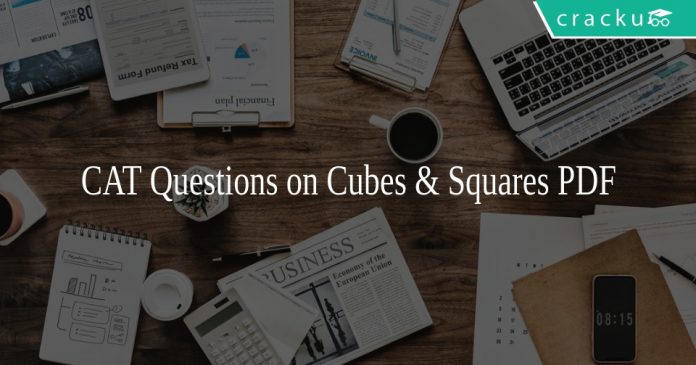CAT Questions on Cubes & Squares PDF:
Download CAT Questions on Cubes & Squares PDF. Practice important problems with detailed explanations for CAT.
Download CAT Questions on Cubes & Squares PDF
Download All Quantitative Aptitude important Questions PDF
Take Free CAT Mock Tests
Question 1: If a number has 12 factors, which of the following cannot be the number of factors of the square of that number?
a) 23
b) 45
c) 30
d) 33
e)35
Question 2: A two digit number has different digits. For how many such two digit positive numbers is the difference between the number itself and the number formed on reversing its digits is the perfect square of an integer?
a) 20
b) 29
c) 38
d) None of these
Question 3: How many 4 digit numbers have their cubes ending with 44?
a) 180
b) 90
c) 45
d) 120
e)0
Question 4: How many factors of 36288 are perfect cubes?
a) 9
b) 4
c) 6
d) 8
CAT Mocks for just Rs. 1180 – Last Day
Answers & Solutions:
1) Answer (C)
If a number has 12 factors, it can be of the following forms-
$X=a^{11}$, in this case $X^2=a^{22}$, so the number of factors of the square is 23.
$X=a^{5}b$ in this case $X^2=a^{10}b^2$, so the number of factors of the square is 33.
$X=a^{3}b^{2}$ in this case $X^2=a^{6}b^4$, so the number of factors of the square is 35.
$X=abc^{2}$ in this case $X^2=a^{2}b^{2}c^4$, so the number of factors of the square is 45.
Thus, the answer is C.
2) Answer (B)
Let the two digit number be ‘xy’
The difference between the number and the number obtained when its digits are reversed is,
(10y-x)-(10x-y) = 9(y-x)
This must be a perfect square.
So it can only take the values of 9, 36 and 81.
It cannot take the value 0 because it is given that the digits of the two digit number are distinct.
If 9(y-x) = 9, then (y-x)=1. There will be 17 numbers such that either y-x = 1 or x-y = 1.
If 9(y-x) = 36, then (y-x)=4. There will be 11 numbers such that either y-x = 4 or x-y = 4.
If 9(y-x) = 81, then (y-x)=9. There will be only 1 number such that x-y = 9, that is 90.
So the total number of numbers possible are 17+11+1 = 29.
3) Answer ()
If the unit digit of the cube is 4, the unit digit of the number must definitely be 4.
=> The number must be of the form ‘abc4’
Since a and b are the thousandth and the hundredth digit number, they won’t contribute to the tens digit number of the cube. Let us find how many values c can assume.
$(10c+4)^3$ gives 44 in the end.
=> $1000c^3 + 64 + 400c^2 + 480c $ ends in 44.
Again $1000c^3$ and $400c^2$ won’t contribute to the last 2 digits.
=> 64+80c ends in 44. This only happens when c=1 or c=6
=> a can assume 1-9 i.e 9 values, b can assume 0-9 i.e. 10 values, and c can assume 2 values. Total numbers= 180.
4) Answer (B)
$36288 = 2^6 * 3^4 * 7$
For any perfect cube, all the powers of its prime numbers have to be multiples of 3.
So, if the factor is of form $2^a * 3^b * 7^c$, a can take values 0, 3, 6
And b can take values 0, 3
And c can take value 0.
==> There are 3*2*1 = 6 possibilities.





![CAT Averages Questions PDF [Important Questions] CAT AVERAGES Questions PDF](https://cracku.in/blog/wp-content/uploads/2022/07/CAT-AVERAGES-Questions-PDF-218x150.png)